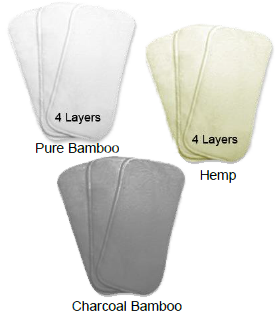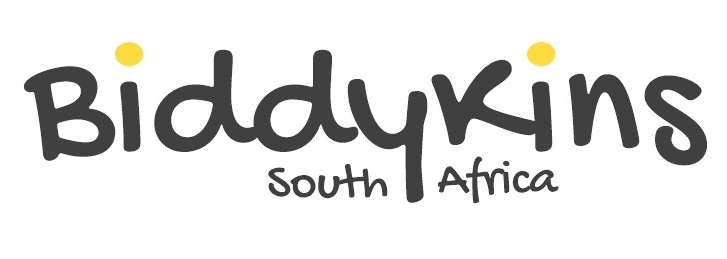Inserts…
 Where the PUL outer fabric is the waterproof
layer and the inner pocket/sleeve lining keeps baby dry (and holds the
inserts in place), the INSERTS are what do all the hard work.
Where the PUL outer fabric is the waterproof
layer and the inner pocket/sleeve lining keeps baby dry (and holds the
inserts in place), the INSERTS are what do all the hard work.
Simply think of them as sponges. Inserts are responsible for absorbing liquids.
BiddyKins nappies may include Microfibre, Bamboo Blend, Pure Bamboo, Charcoal Bamboo Fleece or Hemp inserts.Let's quickly address one very common misconception: There is no such thing as "all natural" fabric, inserts or nappies. Don't be conned by very misleading "poetic" names - such as "all natural" or "environmentally friendly". Microfibre inserts certainly do not grow on trees ... but then again neither do bamboo or hemp inserts. In fact unless you're wrapping the little one's bum in bamboo twigs and leaves - YOU ARE NOT using "environmentally friendly" fabric. To turn bamboo leaves/pulp into fabric requires it to be dissolved in a heap of environmentally UNFRIENDLY chemicals, before being reconstituted into a fabric.
The "environmentally friendly" aspect of cloth nappies has a lot more to do with the fact that you're only using about 25-30 cloth nappies that will decompose relatively quickly - as opposed to thousands of disposables that will lie around in landfills for hundreds of years...
Our advice to moms is to rather concentrate on using the insert that works best as sponge for your needs than worrying about whether it is more environmentally friendly. (And fortunately .... it just so happens that we believe that bamboo fabric generally speaking is a better sponge when used as inserts than microfibre).
There two properties of a sponge that we need to consider: Imagine dipping a sponge into a glass of water and then pulling it out again. How much water did the sponge absorb ? Then if we squeeze the sponge - how much water is squeezed out ? Since inserts really are just "sponges" we can apply these questions to the different types of inserts available. How much liquid can the insert absorb - and then when the little one sits, lies down, or is given a little squeeze - how much liquid is squeezed out of the insert !
Q: So which type of insert works best?
Well really, there is no right answer. Microfibre inserts, made from synthetic materials, are very absorbent and dry very quickly and are very cost effective - which is why they are usually included as the default insert. Unfortunately microfiber comes in in last place in the squeeze test. Despite this, a case can certainly be made for using microfibre inserts - especially over the course of the first year. Remember, due to its aggressive moisture absorption properties, microfibre fabric must never be placed directly against baby's skin as it can dry the skin out too causing irritation – microfibre must always be “stuffed” into the pocket.
Bamboo terry inserts are also very absorbent, a little more so than microfibre, but importantly ‘hold’ the moisture a little better under pressure than microfibre, but do not dry as quickly as microfibre. The white bamboo terry inserts are 4 layers thick: In the case of Bamboo Blend inserts: 2 outer terry bamboo layers & 2 inner microfibre layers. Many moms have found that a combination of a microfibre and bamboo inserts work very well - the microfiber sucks in the liquid quickly and by wrapping the microfiber in bamboo, the bamboo holds the moisture in under pressure. Pure Bamboo inserts are also 4 layers thick. The "pure" part of the name is a bit of a misnomer - since all it actually means is that there are no hidden microfiber layers - all 4 layers are bamboo terry. Bamboo Blend and Pure Bamboo inserts therefore look more or less identical, since the outer layers are the same fabric. Bamboo Blend inserts are slightly 'puffier' due to the microfiber being a little thicker.
Staydry bamboo inserts are essentially white bamboo terry inserts discussed above with an extra 5th layer sewn on top of one side. Since the bamboo terry does feel moist against the skin when wet. By adding a staydry layer on one side, a normal bamboo terry insert can be used with waterproof covers (shell only – i.e. not pockets), providing the benefit of a very absorbent bamboo insert plus still leaving baby feeling dry. Later, as baby gets closer to potty training, the insert can be flipped over, with the bamboo side face up - so that baby starts feeling a little more uncomfortable. There is no benefit to stuffing a staydry insert into a pocket – since the lining of the pocket is already the staydry layer. Staydry inserts are more intended for use with waterproof covers, or when the insert is to be laid on top of the nappy (i.e. not stuffing into a pocket/sleeve). This is also the reason why we include one staydry bamboo insert along with each of our hemp fitted nappies - since it offers the staydray layer.
Charcoal bamboo fleece inserts are also more absorbent than microfibre inserts. The fleece fabric also feels drier against the skin than the bamboo terry inserts. Being dark, they dry significantly faster on the line too. Charcoal bamboo fleece inserts really are a great option.
Hemp inserts (specifically hemp fleece - not the thinner and less absorbent hemp jersey) are the most absorbent inserts - a great option as the little one becomes a bit older and starts peeing more. Hemp inserts do become stiff after drying on the line, however popping them into the tumble dryer, or simply “working” them by hand sorts this out to a degree. Since they’re so absorbent, hemp inserts are great for night time use. Note: Since hemp are so absorbent they take a long time to dry on the line – they absorb a lot of water during the washing cycle! This can be problematic during cooler months or along the humid coast where drying times increase considerably. As is the case with all clothing, to help the inserts to last as long as possible, we recommend allowing inserts to line dry for as long as possible– and using tumble driers as a last resort or on rainy days.
Keep in mind that just because hemp is the most absorbent - that does not necessarily make it the best insert for any situation. It is significantly more expensive, does not absorb as quickly as microfibre or bamboo and and takes a lot longer to dry.
Q: How many inserts must I use?
There really is no one size fits all answer. Remember that all babies and their moms are different - as are their feeding/drinking routines and requirements. Understanding the three components - the waterproof layer, the staydry lining and then the sponges (inserts) is the first step. Which inserts to use then really comes down to whichever combination works best for you, for the situation. As a general guide we recommend using two inserts (a microfibre AND a bamboo, or two bamboo inserts) with each nappy during the day for changes ± every two hours – as one would with disposables. Since the insert is the absorbent layer, adding a second insert effectively doubles the absorbency of the nappy. Two inserts per nappy are usually enough absorbency to achieve the desired 2-3 hours during the course of the first year (the level of absorbency is related to output - not age - but as the little gets older, the output obviously increases ...).
Pockets can usually take
about 3 to 4 inserts. Adding too many inserts however can make the nappy
bulky – and even lead to leaks if the nappy no longer seals nice and
tight around the thighs. Always keep in mind that all babies are
different – their fluid intakes vary and this must be taken into account
when deciding which inserts to use.
Whilst some moms find that 2 or even 3 bamboo inserts are sufficient
beyond the first year, in our experience there does come a time when
hemp needs to be added as an insert.
Hemp inserts are also excellent for use as boosters at night. Using one hemp insert (or even two for heavier wetters) along with two bamboo inserts can be sufficient for night time use during the course of the first year, but again as outputs increase, additional absorbency is required. The BiddyKins hemp fitted nappy (to be used along with a waterproof cover) was specifically introduced to be used as a night nappy. Since they're only used at night - 3 or 4 hemp fitted nappies with 2 covers is usually sufficient (washing 2 - 3 days).
Layering inserts: Microfibre usually goes on top (closest to the bum but always inside the pocket-i.e. under the staydry lining - never directly against the skin), then bamboo, then hemp as the furthest layer away from the bum. Hemp fleece has a fluffy side and a smoother side - it really doesn't matter too much which way round the hemp insert is fitted.
Still unsure which to use or how many ? No problem ... simply drop us an email and ask ! That's what we're here for ...
